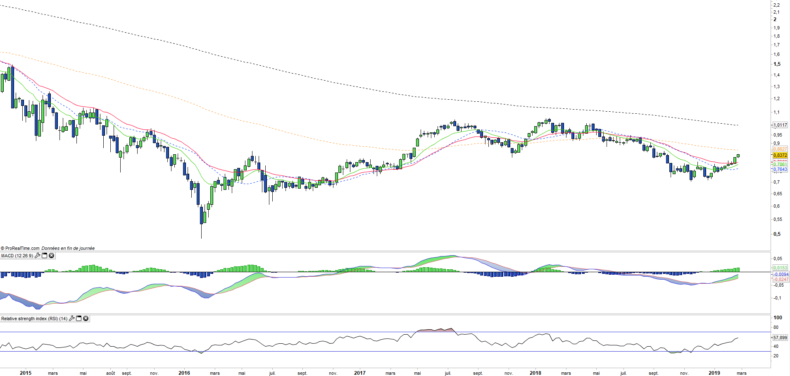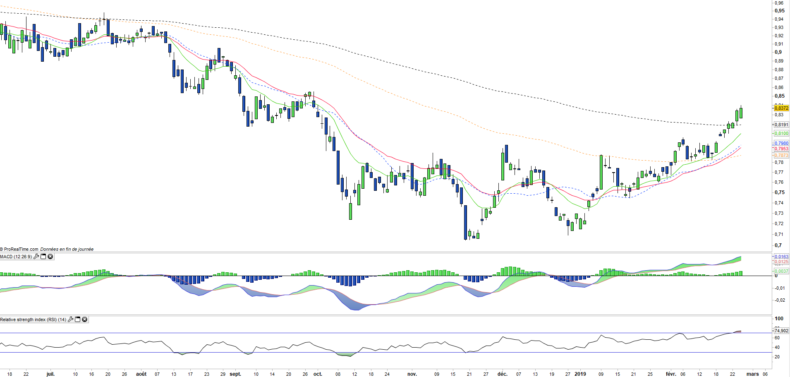Lyxor FTSE ATHEX Large Cap (GRE) - 26/02/19
Short Term strategy: Positive (70%) / Trend +
Long Term strategy: Negative (10%) / Trend =
Characteristics of the ETF
The ETF GRE (Lyxor) created in 01/2007 quoted in Euro on Euronext and replicates the index FTSE ATHEX LARGE CAP Total Net Return composed of the 22 largest companies listed on the Athens Exchange (ATHEX).
The fees of this ETF are 0.45% for AUM of € 153m. The replication method is indirect (via swap) and there is an annual dividend distribution policy.
Alternative ETFs: GREK (Global X in USD)
Index & components
The ETF GRE is composed of 22 companies, so it is rather narrow compared to the other national indices but finally quite diversified with 18% for the financial sector which gathers the main banks of the country (Alpha Bank, National Bank of Greece, Eurobank ergasias , Piraeus Bank), the consumer goods sector accounts for 29% (mainly the Coca-Cola subsidiary), 12% for telecoms (Hellenic Telecoms), while the industrial sector (Cement, energy, materials) represent essentially the remaining part, note the presence of a gaming company: OPAP, which accounts for nearly 9% of capitalization.
The Greek economy is roughly at the level of Portugal, with a GDP of about € 190 billion. The worst seems over for Greece, which returned to growth in 2016 at + 0.3%, with an acceleration of + 1.4% in 2017 and + 1.6% in 2018. Thanks to the diversification, country has replaced agriculture as the second largest source of income after services, accounting for 15.7% of GDP and employing 15% of the labor force, although its share was larger (20% ) before the 2007 economic crisis. The main sectors are electronics, transportation equipment, clothing and construction. Greece has the largest maritime fleet in the world and the tertiary sector accounts for 80% of GDP and employs 71% of the active population while tourism alone contributes 11% of GDP.
Greece has an international-oriented economy, with trade accounting for 64% of GDP, and Greece's main trading partners are the European Union (especially Italy and Germany), Turkey and Russia. Economic activity is in recovery including the banking sector, which continues to stabilize, and a more favorable context. The rating agencies note their rating one after the other.
After a lost decade, Greece seems to be able to gradually regain its financial and budgetary autonomy.
Latest developments
GRE grew by 22.2% in 2017 but fell by more than 25% in 2018 due to recession fears in Europe. The index rebounded in 2019 with all the world's places and post an increase of 14.4% YTD.
After several years of deep recession and three aid programs of € 289 billions, the country is doing better today but remains extremely fragile: unemployment has just dropped below 20% after peaking at 27.5% in 2013 and a quarter of GDP evaporated in eight years.
Eight years after the beginning of the austerity imposed on Greece, Athens last summer turned the page of its trusteeship by starting to finance itself on the markets. Greece raised € 2.5 billions at the end of January, confirming its return to the markets with a rate of 3.6% and a coupon below 3.5%. Total bids reached almost € 10 billions for this bond, which expires in April 2024. This transaction marks the country's ability to refinance itself on the markets, and attests to the improvement in the Greek economy after nearly a decade of crisis.
Elections will be held in september, which implies an area of uncertainty but should not jeopardize the recovery.
Weekly data
The weekly chart shows a strong rebound in recent weeks that propels the index above its short term averages, but still below the EMA100 which split the direction of the trend in the longer run. The index is therefore in a dynamic rebound phase, but not yet in a medium-term positive trend. We will monitor the MACD which is still a good distance from its zero line.
Daily data
On the daily chart, we can clearly see the short-term upward acceleration that leads to the overshooting of the EMAs100 and 200, which significantly improves the technical situation of the index. However, the index remains "capped" by a bearish line that should be a drag on the rise for a while. The €0.88 / 0.90 zone is therefore pivotal and represents the major short-term resistance zone.
Theme
GRE is a UCITS ETF, listed in EUR, which seeks to replicate the MSCI Greece IMI + Coca-Cola 20-35 Net Total Return index (22 companies)
Characteristics
| Inception date | 05/01/2007 |
| Expense ratio | 0,45% |
| Issuer | Lyxor |
| Benchmark | FTSE ATHEX Large Cap |
| Code / Ticker | GRE |
| ISIN | FR0010405431 |
| UCITS | Yes |
| EU-SD Status | Out of scope |
| Currency | € |
| Exchange | Euronext Paris |
| Assets Under Management | 153 M€ |
| Replication Method | Indirect (swap) |
| PEA (France) | Yes |
| SRD (France) | Yes |
| Dividend | Capitalization |
| Currency Risk | Yes |
| Number of Holdings | 22 |
| Risk | 4/5 |
Country Breakdown
| Greece | 72% |
| Switzerland | 28% |
| Belgium | 1% |
Sector Breakdown
| Consumer Staples | 29% |
| Financials | 17% |
| Consumer Discretionary | 17% |
| Communication Services | 12% |
| Industrials | 8% |
| Energy | 6% |
| Materials | 4% |
| Others | 7% |
Top Ten Holdings
| Coca Cola HBC | 28% |
| Hellenic Telecom | 12% |
| OPAP | 9% |
| Jumbo SA | 7% |
| Alpha Bank | 7% |
| Motor Oil | 6% |
| Eurobank Ergasias | 5% |
| Titan Cement | 4% |
| Mitilineos Holdings | 4% |
| National Bank of Greece | 3% |


